
The big red spot most kids are familiar with is actually a huge, gaseous storm that has raged for hundreds of years. This orange and red planet is the largest of the planets and has dozens of moons.

These plates are very sensitive to the drilling processes we perform to harvestĪnd can cause many man-made communities grief when tampered with. Talk about your family’s favorite natural wonders on Earth, and how they form through movement by the plate tectonics beneath Earth’s crust. Olympus Mons is 16 miles high, making it about three times higher than Mount Everest. Your closest space neighbor (and my personal favorite), Mars has the highest mountain in the solar system. This is a great way to talk about greenhouse gasses and their polluting effect on Earth over time. VenusĪ strong greenhouse effect takes place beneath Venus’s thick clouds-which are so dense it makes the surface much hotter than we’d be able to live in. Talk about how short seasons would be on Mercury compared to Earth, and how our food growing season would shorten. One entire day (the time it takes for a planet to spin, or fully rotate on its axis, once) on Mercury takes almost 176 Earth days! Its orbit around the Sun (measured as a year) takes just 88 Earth days. Its rotation and orbit are very different than ours, with long days and short years. The closest planet to our sun is also is the smallest planet in our solar system, measuring just a bit larger than our Moon. Teaching your kids some solar system facts about the other planets will allow them to compare and contrast them to their home planet. This knowledge could shrink your family’s carbon footprint. By knowing how different and special their planet is, and how important it is to the ecosystem, they’ll be more willing to conserve the resources on it.

This includes using only what you need and doing your best to keep it clean-both of which can help your kids develop an interest in the solar system.

Organisms like you, your family, and your dog or cat can’t live without water, so we need to take care of the supply we do have. Because of this, Earth is the only planet with life. Why We’re DifferentĮarth is the only planet in the solar system that’s known to have water (Jupiter’s moon Europa may have frozen water, but this has yet to be confirmed). Here’s how teaching the solar system for kids to understand helps them realize how fragile and important their home is.

Involving my kids in my (admittedly deep) interest and study of space has pushed me to learn even more. But it’s captivating to look beyond our own small, blue planet and survey the rest of the solar system to gain a further appreciation for our natural resources. There’s a lot of talk in the green scene about how there’s only one Earth and we need to take care of it, and this couldn’t be


 0 kommentar(er)
0 kommentar(er)
